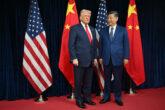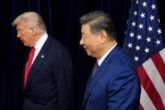August 10, 2018
How South Korea’s ‘New Economic Map’ Could Shift Northeast Asia’s Balance of Power
Since assuming office in May 2017, South Korean President Moon Jae-in is proving to be nothing short of a visionary. But the flurry of summitry surrounding North Korea’s nuclear program since the 2018 Winter Olympics in PyeongChang has overshadowed an equally ambitious plan that has been brewing in the Blue House for building toward peaceful reunification of the two Koreas.
Moon’s proposition is a simple, yet potentially transformative one: create a railway system that connects South Korea and North Korea to Russia, China, and Europe. The goal is not simply to alter Pyongyang’s strategic calculations with regard to its still-active nuclear and related weapons programs but to turn the Korean Peninsula into a new growth engine for Northeast Asia. This could fundamentally alter the Northeast Asian regional balance of power, positioning North Korea as a critical node that connects East Asia to Eastern and Central Europe.
Moon’s economic plan is not without precedent. Previous South Korean presidents, including Kim Dae-jung with his original Sunshine Policy, envisioned a phased process toward reunification that included economic and rail links between the Koreas. The 1994 Agreed Framework between the United States and North Korea sought to provide Pyongyang a measure of energy security, first through the provision of heavy fuel oil, then through two light-water nuclear reactors. And Russian governments have, for the past decade, called for completing gas pipeline projects that run through North Korea and connecting rail transit across the Eurasian continent.
But the historic Trump-Kim summit in Singapore breathed new life into Moon’s so-called “New Economic Map of the Korean Peninsula,” which he most recently showcased at the 42nd annual Singapore Lecture in July. The two most striking features of this new regional connectivity vision focus on energy and overland transportation. Specifically, Moon envisions the construction of a trans-Korean gas pipeline that would bring Russian gas through North Korea down to South Korea’s industrial hubs, as well as a railway system to link Seoul to Kaesong, Pyongyang, Nampo, and Sinuiju in North Korea — and on to Dandong and Beijing in China. From Beijing, the Trans-Mongolian and Trans-Siberian railways could then make it possible to transport overland freight from South Korea’s southernmost coastal cities all the way to Europe.
Read the Full Article at The Diplomat
More from CNAS
-
Chinese Maker of Bitcoin-Mining Machines Is a Security Threat, Says Expert
Bloomberg News reports that a Chinese manufacturer, Bitmain Technologies Ltd, that sells most of the world’s Bitcoin-mining machines — including 16,000 of them to a venture ba...
By David Feith
-
Indo-Pacific Security / Energy, Economics & Security
North Korea’s Provocations, Power Plays, and Shifting AlliancesTensions on the Korean Peninsula have reached a new and dangerous threshold. President Lee Jae Myung is warning of a real risk of accidental military clashes, as the situation...
By Dr. Go Myong-Hyun
-
Indo-Pacific Security / Energy, Economics & Security
How to Win the Economic War with ChinaTrump's approach to China has run aground, giving Beijing unprecedented advantage in the economic conflict....
By Edward Fishman & Julian Gewirtz
-
Indo-Pacific Security / Technology & National Security
Sharper: Tech + ChinaRecent talks between President Donald Trump and Chinese Communist Party General Secretary Xi Jinping placed a spotlight on emerging technologies, from high-end chips to minera...
By Charles Horn & Sevi Silvia




